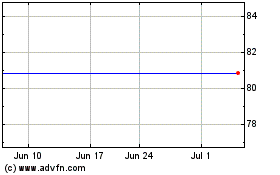St. Jude Medical Discovers Cosmic Radiation Can Affect Memory Chip in Limited Number of Older Generation ICDs
October 07 2005 - 7:00AM
Business Wire
St. Jude Medical Inc. (NYSE:STJ) announced today that it has
discovered that background levels of atmospheric ionizing cosmic
radiation, more commonly known as cosmic rays, can affect a limited
number of its older generation implantable cardioverter
defibrillator (ICD) products. Although the incidence rate is low,
and there have been no serious patient injuries or deaths reported
to St. Jude Medical attributable to this anomaly, the Company is
taking a conservative approach in advising the medical community
and regulatory agencies. Specifically, St. Jude Medical has
identified through extensive investigation, including testing at an
independent nuclear laboratory, that a particular vendor-supplied
static random access memory (SRAM) chip can be affected, at a low
frequency rate, by background levels of atmospheric ionizing cosmic
radiation. A full copy of the physician communication, which
includes a description of the anomaly and its related clinical
risks, as well as St. Jude Medical's recommendations to physicians
for patient monitoring, can be found at
http://www.sjm.com/companyinformation/physicianletter.html. This
particular memory chip component was used in the following older
generation St. Jude Medical ICDs: -- Photon DR (Model V-230HV)
(certain serial numbers) -- Photon Micro VR/DR (Models V-194/V-232)
-- Atlas VR/DR (Models V-199/V-240) To date, an incidence of only
0.00167 of the devices at issue (60 out of 36,000) have been found
to have been affected by background levels of cosmic radiation. An
estimated 26,000 of the device models remain in service. The
estimated incidence of an anomaly of this type in the affected
device models is 0.00257 over the five year projected life of the
device. "St. Jude Medical has taken a conservative, proactive
approach in notifying the medical community of this anomaly," said
Dr. Mark Carlson, Professor of Medicine at Case Western Reserve
University in Cleveland, Ohio, and a member of an independent panel
of physicians that reviewed the issue for St. Jude Medical. Dr.
Carlson also recently served as Chairman of a joint Policy
Conference on Pacemaker and ICD Performance. Among the information
provided in the physician advisory is St. Jude Medical's
recommendation that, if it is not already their practice,
physicians should perform routine device monitoring every three
months for patients with these devices. St. Jude Medical is also
offering its remote monitoring product Housecall Plus(TM), where
available, at no charge for models compatible with the remote
monitoring system. "Because the incidence associated with this
anomaly is low, St. Jude Medical's recommendation for monitoring at
three-month intervals will be appropriate for the vast majority of
patients," said Dr. Bruce Wilkoff, director of cardiac pacing and
tachyarrhythmia devices at The Cleveland Clinic and Heart Center
and a member of the St. Jude Medical independent Medical Advisory
Board. As part of a new ICD product platform introduced in 2002,
and prior to St. Jude Medical having any knowledge of this
particular anomaly, St. Jude Medical began using a different vendor
and a different design of the SRAM memory chip component.
Laboratory testing and clinical experience indicate that this newer
generation memory chip component does not share the same
susceptibility to background cosmic radiation as the earlier
generation. Consequently, other St. Jude Medical ICDs and all
models of CRT-D devices, including the Atlas DR model V-242 and all
Epic, Epic HF, Epic +, Epic + HF, Atlas + and Atlas + HF product
families, are NOT affected by this issue. Overall reliability
information about the affected ICDs and other St. Jude Medical
products can be found in the company's Product Performance Report
on the St. Jude Medical web site at www.sjm.com. St. Jude Medical
has notified the U.S. Food and Drug Administration (FDA) of this
physician advisory. The FDA may determine this communication action
to be a recall. The Company does not expect this physician
communication to have any material financial impact. St. Jude
Medical is dedicated to the design, manufacture and distribution of
innovative medical devices of the highest quality, offering
physicians, patients and payers outstanding clinical performance
and demonstrated economic value. Any statements made regarding the
Company's anticipated future product launches, regulatory
approvals, revenues, earnings, market shares, and potential
clinical success are forward-looking statements which are subject
to risks and uncertainties, such as those described in the
Financial Section of the Company's Annual Report to Shareholders
for the fiscal year ended December 31, 2004 (see page 16). Actual
results may differ materially from anticipated results.
SJM (NYSE:STJ)
Historical Stock Chart
From Jun 2024 to Jul 2024

SJM (NYSE:STJ)
Historical Stock Chart
From Jul 2023 to Jul 2024
